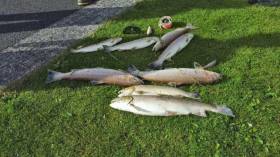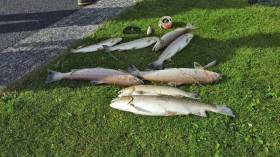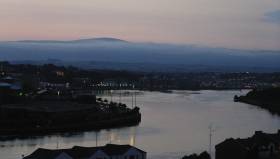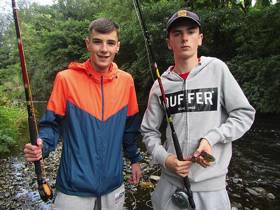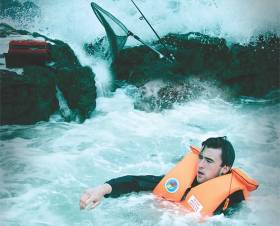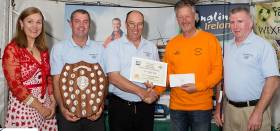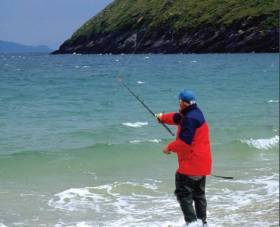Displaying items by tag: angling
Cracked Pipe Led To Fish Kill On Co Down River
#FishKill - The fish kill on the Annsborough River in Co Down last weekend was caused by a chemical leak from a cracked pipe, accoridng to BBC News.
And NI Water has offered to restock the salmon and sea trout stream, one popular with local angling enthusiasts, days after the incident at its water treatment plant in the area.
As previously reported on Afloat.ie, some 1,600 fish were killed when the river was polluted by what’s since been confirmed as a polyelectrolyte used in processing water treatment byproducts.
"The severity of this incident is very unusual for our company. We truly regret the outcome and the number of fish that have been killed,” said NI Water in a statement.
BBC News has more on the story HERE.
Salmon Life Cycle Video Nets ‘Something Fishy’ Prize For Sligo Pupils
#SomethingFishy - Pupils at Scoil Chroí Naofa in Bunninadden, Sligo have been named the national winners of Inland Fisheries Ireland’s Something Fishy competition for 2016 at an event in Sligo’s Clarion Hotel yesterday (Wednesday 12 October).
The winning group of 24 children from the school’s senior class take home the National Something Fishy Award and €700 for their animated short on the life cycle of the salmon – selected by an independent judging panel comprising fisheries officers and education staff.
Along with their teacher Adrian Ormsby, the class edited and produced the digital and artistic photo story during the previous school term.
The ‘Something Fishy’ programme is an educational initiative of Inland Fisheries Ireland (IFI) in partnership with Blackrock Education Centre, which allows students to learn about fish and the environment in a local context.
The 2016 programme saw 3,776 children taking part in 118 schools and 11 education centres nationwide. Students were invited to submit project entries into the competition with this year’s entries addressing the theme ‘Focus on Learning’.
“The standard of entry to this year’s Something Fishy competition was particularly high and it is fantastic to have so many children engaged on our fisheries resource,” said IFI chief executive Dr Ciaran Byrne.
“Something Fishy gives children an opportunity to learn valuable lessons about the importance of protecting and conserving the aquatic environment but perhaps more importantly, they are also empowered to share their learnings with their peers via digital projects which can be enjoyed by all.”
Bernie Burke, principal of Scoil Chroí Naofa, described the win as “a fantastic achievement by the students involved who have thoroughly enjoyed taking part in the programme.
“They have discovered the magical world within our waterways and enjoyed learning all about the aquatic environment. I would like to congratulate each of them and their teacher Mr Ormsby on all their hard work.”
Since the inception of Something Fishy in 2005, some 50,000 children have participated in the initiative which aims to promote interest and understanding in fish and their habitats.
As part of the educational programme, IFI fisheries officers visit schools and provide classroom-based assistance, with a full range of resources for teachers and children also available on the Something Fishy website.
Together, they explore the themes of fish, habitats, angling, water environment and the protection and conservation of Ireland’s rivers and lakes.
Aside from school-based learning, fisheries officers take students into the field to give them some practical experience of their work.
Major Fish Kill On Co Down River After Chemical Spill
#FishKill - Accidental discharge from a water treatment works is to blame for a major fish kill incident on a Co Down river at the weekend, as the Belfast Telegraph reports.
Angling enthusiasts have expressed dismay over the deaths of more than 1,600 fish on a tributary of the Annsborough River that flows into Dundrum Bay near Newcastle, after making the grim discovery on Saturday 8 October.
The Northern Ireland Environment Agency is currently investigating the incident, which NI Water has admitted was caused by an accidental discharge of chemicals into a river known locally for salmon and sea trout.
The Belfast Telegraph has more on the story HERE.
Earlier today Afloat.ie reported on concerns among Northern Irish anglers over spikes in pollution and poaching on the country’s waterways.
NI Anglers Concerned By Rise In Pollution & Poaching
#Angling - Pollution and poaching are a growing concern for anglers in the Carlingford and Lough Foyle areas, as Derek Evans reports in his latest Angling Notes for The Irish Times.
New figures from the Loughs Agency reveal a significant raise in pollution, the worst incident of which occurred this past August when hundreds of salmon fry were lost in a fish kill on the River Faughan, according to the Derry Journal.
In addition, the Loughs Agency report informed NI Environment Minister Michelle McIlveen of almost double the number of fishing gear seizures this year compared to 2015, as well as a sharp rise in court actions.
The Irish Times has more on the story HERE.
Angler Prosecuted For Illegal Fishing In Claregalway
#Angling - Judge Marie Keane has convicted Belfast man John Beales of illegal fishing and obstruction of fisheries officers over an incident on the Clare River in Claregalway on 13 July 2015.
Beales was convicted for failure to attach a gill tag to a wild salmon under Section 3 of the Wild Salmon and Sea Trout Tagging Scheme Regulations and for obstruction under Section 301(7) of the Fisheries (Consolidation) Act, 1959.
Inland Fisheries Ireland (IFI) officers Conor Dennedy and Paul Reynolds attended court and gave evidence of events to Judge Keane at a sitting of Galway District Court on the 30th of September.
Officer Dennedy told how they were on a foot patrol on the Clare River on the date in question he saw an angler, later identified as Beales, fishing downstream of the bridge. When Beales noticed the fisheries officer, he concealed his fishing equipment and walked towards him.
Beales denied he had been fishing when questioned by Officer Dennedy. However, upon inspection of Beales’ van, Officer Dennedy found two salmon, one trout and two mounted fishing rods. One of the salmon had a tag for the Foyle Fisheries Area issued to Beales affixed to it, which is only valid in the Foyle area.
Beales became aggressive when questioned by fisheries officers and was later directed to leave the area by gardaí under the Public Order Act.
Initially, IFI issued Beales with a fixed charge penalty notice for the offence, but despite reminders, he did not pay. As a result, Beales was prosecuted and brought to court.
Judge Keane accepted the evidence of the fisheries officers in court and imposed fines totalling €900, as well as costs of €500. She also made a Forfeiture Order in respect of all items seized on the day from Beales.
#Angling - Inland Fisheries Ireland (IFI) is looking for public feedback via an online survey on its current funding programmes, having awarded over €3.4 million to angling projects and fisheries initiatives in communities nationwide over the past five years.
Current funding channels include the Salmon Conservation Fund and the Midlands Fisheries Fund, which see IFI redistribute income gained from permits and licenses, as well as IFI’s Sponsorship Programme.
IFI is now looking to consult with previous recipients of funding alongside interested parties and potential applicants, on whether the funding programmes are meeting requirements and if there are any changes which could be made to improve them.
Sean Kyne TD, Minister of State with responsibility for the Inland fisheries sector, encouraged stakeholders to take part in the online survey.
“The programmes ensure that stakeholders are facilitated and partnered to assist in the strategic development of fisheries and angling developments,” he said, adding that “the angling sector is worth €836 million to Ireland’s economy annually, supporting upwards of 11,000 jobs.”
This month IFI will invite applications for funding for angling access improvement works. These projects should contribute to the delivery of an accessible and sustainable world class inland fisheries and sea angling resource and will form part of the National Strategy for Angling Development.
While this fund will be limited to ‘shovel ready’ projects on the river bank, further funding opportunities for more complex capital projects are likely early in 2017.
The funding survey should take less than five minutes to complete with all participants entered into a draw to win one of three €50 tackle shop vouchers. The survey is open to angling clubs, commercial fishermen, fishery promoters, community and local development groups as well as private individuals.
To find out more information about IFI’s funding programmes and to take the short funding survey, visit www.fisheriesireland.ie/fundingsurvey.
The survey will be live on the IFI website until Tuesday 8 November.
Fishing For Beginners With Whitechurch Youth Group Hailed A Success
#Angling - Whitechurch Youth Group from Rathfarnham in Dublin has once again taken up angling as part of Inland Fisheries Ireland’s Dublin Angling Initiative (DAI).
The youth group recently embarked on lessons in the basics of fly fishing, one of the most popular forms of angling.
Students picked up the basics of fly fishing equipment, fly tying and fly casting very quickly. And after a couple of lessons on dry land in Whitechurch, they were ready to go to the river bank and put their skills into practice at a popular angling spot in Milltown.
That’s where Matthew McDonald caught a wild brown trout assisted by his friend Nicky O’Hagan on their first fishing trip with the DAI.
Whitechurch Youth Group previously ran a fly-tying programme for fly fishing during the Winter months for several years. After a two year break from fly-tying, they have decided to re-introduce it to the youth group’s programme over the next few months.
IFI’s initiative offers young people from national and secondary schools, summer projects and youth services the opportunity to attend fishing courses throughout the summer.
Among them are young people from the Sphere 17 youth group in Darndale, North Dublin, who took part in a nighttime fishing event in Maynooth recently.
To date, thousands of young people have been introduced to sea, coarse and game angling and the initiative has been a catalyst in setting up fishing clubs for young people throughout the country.
“We have partnered with Whitechurch Youth Group for many years in showing young people what fishing is all about,” said DAI co-ordinator Oisin Cahill. “Fly Fishing is a particularly enjoyable type of fishing and it was great to see how quickly the youth group members picked up the art of fly tying and casting.
“Fishing is a hobby which can be enjoyed at any age. It is fantastic to see so many young people take up angling through the Dublin Angling Initiative.
“We would encourage anyone interested to try it out and discover a pastime which will have a positive impact on your health and wellbeing as well as being good fun.”
For further information on the DAI, visit www.fisheriesireland.ie or contact Oisin Cahill at [email protected].
Anglers Urged to Stay Safe on the Water
Inland Fisheries Ireland and Irish Water Safety have outlined water safety advice in light of 18 angling related deaths in last three years.
Anglers in Ireland are reminded of the importance of staying safe on the water as they enjoy fishing on Ireland’s rivers, lakes and seas. There have been 18 angling related drownings in Ireland since 2014 according to Inland Fisheries Ireland and Irish Water Safety, who have joined forces to highlight water safety to the angling community.
Drownings relating to angling are quite common in Ireland with four deaths reported this year. There were nine deaths reported related to angling in 2015 and a further five in 2014. In total, 122 people drowned in Ireland last year, equating to ten deaths every month with drownings often happening quickly, silently and in shallow water. Irish Water Safety advises anglers to follow these steps to avoid any danger on or near the water:
- Wear a lifejacket when on or near the water and make sure that it has a correctly fitting crotch strap.
- Supervise children at all times near water - 30 children aged 14 and under drowned in the last ten years.
- Check locally concerning dangerous currents and carry an alternative means of propulsion.
- Train for your aquatic activity at www.safetyzone.ie.
- Watch for changing weather. Be prepared to seek shelter in good time.
- Learn swimming and lifesaving skills, available nationwide for all ages through Irish Water Safety.Avoid alcohol as it impairs judgment, balance and coordination, all of which are essential for boating.
- In Marine Emergencies, call 112 and ask for the coastguard.
Ireland is a popular destination for angling with 74,000 kilometres of rivers and streams, 128,000 hectares of lakes and over 5,500 kilometres of coastline. There are approximately 273,000 domestic anglers in Ireland with a further 163,000 visitors enjoying fishing during a trip to Ireland in 2015.
Suzanne Campion, Inland Fisheries Ireland said: “Ireland is a popular and unique location for fishing which we want anglers to enjoy. Angling can have a positive effect on health and well-being and it is something that can be enjoyed at any age or ability. In light of recent tragedies however, we would appeal to anglers to wear a life jacket at all times whether near or on the water and to follow Irish Water Safety’s top tips to stay safe at all times.”
Irish Boat ‘Screaming Reels’ from Cork Wins Rosslare Small Boats Festival for Eighth Time
The Irish boat ‘Screaming Reels’ has won the Rosslare Small Boats Angling Festival for a record eighth year in what was a very tight competition. This is the sixth year in a row that the crew from Rosie’s Sea Angling Club from Midleton in Cork, who first started fishing the competition in 2008, has won. They beat 43 other boats from Britain and Ireland catching 30 different species of fish for 28.03 kilos. This prestigious competition generates in the region of €300,000 for the local economy, bringing jobs and employment to Wexford.
Sponsored by Inland Fisheries Ireland, Garmin, DAIWA, Wexford County Council, Fáilte Ireland, Sea Angler magazine and IPB Insurance, the 31st festival attracted more than 138 anglers from Wales, Scotland, Isle of Wight, Manchester, Liverpool and Portsmouth as well as domestic anglers from Ireland. The high standard of competition, combined with a quality angling product, continues to attract the best boat anglers in Great Britain and Ireland in what is now regarded as the finest small boat fishing competition in Europe. This was evident again this year with 12 new boats attending the Festival, with many coming from Wales.
Weather conditions on the day were challenging with gale force winds delaying the start of the competition. The winds eased during the week allowing boats to be launched from Kilmore Quay every day enabling them to target all species. The competition was fierce and the boats recorded up to 21 species on the first day (a new record) with the boat ‘Even Less’ in the lead for the first two days. This continued throughout the week with many boats neck and neck over a number of days.
One third of the boats caught 22 different types of fish species with 36 different fish species recorded in total throughout the festival. It was ‘Screaming Reels’ from Midleton, Cork however who got to the finish line first with 30 species of fish after four days fishing. The heaviest fish was a bull huss of 6.25kgs caught by Ralph Barkley on the boat ‘Seeker’.
The winning boat ‘Screaming Reels’ consisted of crew Martyn Rayner (skipper) Seirt Shults and Neville Murphy who have continued to raise the bar of the Rosslare Small Boats Fishing Competition. Second place went to the boat ‘Even Less’ (Wesley Lewis, Steve Mills and Steve Arnold) from Gosport Angling Club in Portsmouth with 28 species for 16.10 kilos. In third place was ‘Joe 90’ (John Meaning, Dave Weatherby and Graham Cuff) from the Isle of Wight with 26 species for 21.16 kilos.
Inland Fisheries Ireland was present at the event with a marine fish tank for the purpose of displaying fish species that were caught during the competition. Staff from Inland Fisheries Ireland were on hand to educate the public about the fish species on offer from Kilmore Quay. The educational benefits of the marine tank and practising catch and release for marine species are hugely beneficial in terms of conservation and creating public awareness of Ireland’s marine resource. The public were able to view marine fish such as ballan wrasse, smoothound, gurnard and dabs which were kept in the fish tank and released back into their marine habitat alive. An overwhelming effort was made by anglers to release marine species back alive to the ocean, which was hugely supported by Kilmore Quay harbour master and staff at Wexford County Council.
The prize giving ceremony took place at ‘Redmond’s The Bay, where there were fantastic prizes worth in the region of €20,000 on offer including fishing equipment, cash prizes and engraved trophies. A presentation was made to the RNLI in Kilmore Quay who were represented by Johnny Moore who anglers thanked for their generosity.
John Belger, UK organiser of the competition said: ‘I would like to congratulate all competitors on their success at the 31st Rosslare Small Boats festival. I would also like to thank our sponsors Garmin, DAIWA, Inland Fisheries Ireland, Wexford County Council, Fáilte Ireland, Sea Angler magazine and IPB Insurance for their generosity and look forward to seeing you all next year’.
The Rosslare Small Boats Festival 2017 will take place from the 9th – 16th September 2017.
Inland Fisheries Ireland Plan Aims To Boost Irish Angling Sector Worth €836m
Inland Fisheries Ireland (IFI), the state agency responsible for Ireland’s inland fisheries, has launched its new Corporate Plan 2016-2020. The plan sees IFI setting out ambitious goals to drive its work around the protection, conservation, promotion and development of Ireland’s fisheries resource over the next five years. Among these goals is the growth of angling with a view to increasing the number of domestic and international anglers in Ireland. Angling in Ireland is currently worth €836 million to Ireland’s economy annually, supporting upwards of 11,000 jobs.
IFI’s Corporate Plan also focuses on the protection and conservation of freshwater fish species in Ireland and it outlines how modern protection services incorporating technology will efficiently protect the resource. Staff have recently adopted new technologies to help them protect Ireland’s rivers and lakes with Fisheries Officers now routinely using equipment such as spotting scopes, night sights, thermal imaging equipment and mobile phone apps to assist them in their work. They are also using kayaks, all-terrain vehicles, quads and bikes on fisheries patrols.
IFI has also outlined a greater focus on fish habitats and their development to ensure fish populations thrive, an objective which will be progressed as part of the implementation of the National Strategy for Angling Development (NSAD), the first comprehensive framework for the development of the Irish angling resource. The future health of Ireland’s angling resource is dependent on ensuring that Ireland’s fish populations and habitats are protected and conserved. This Strategy will deliver significant economic benefits in rural communities where much of angling takes place. It also offers the opportunity to improve the current economic impact of angling by €60 million per year and to support an extra 1,400 Irish jobs.
Ciaran Byrne, CEO of Inland Fisheries Ireland said: “Inland Fisheries Ireland has a huge jurisdiction with 74,000 kilometres of rivers and streams, 128,000 hectares of lakes and over 5,500 kilometres of coastline. Over the next five years, IFI will utilise information and communication technologies and equipment to secure greater efficiencies in the protection of these fisheries.
We know that angling is at a turning point in this country and it is vital that we reinvigorate the sector. Angling supports economic development opportunities and jobs, often in rural and peripheral communities. This plan outlines how with the right budgetary and staff resources, we can maximise the potential of the resource while also ensuring that our environmental stewardship leaves the inland fisheries and sea angling sectors in a better position.”




























